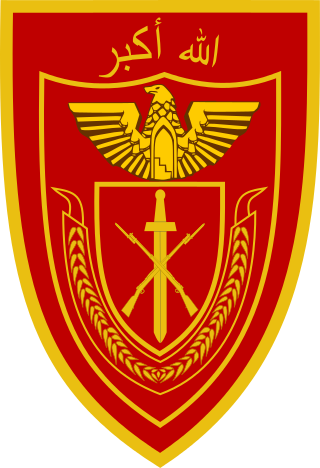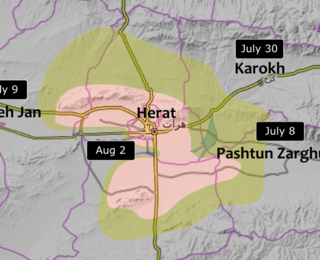Battle
On 21 June, Taliban captured the entrance to the Kunduz city before dispersing throughout its neighborhoods. [23]
By 23 June, Taliban had laid the siege of Kunduz city after capturing districts in vicinity of the city and the main border crossing with Tajikistan. [24]
On 24 June, an airstrike by an Afghan Air Force in Eighth Police District of Kunduz City killed two Afghan police officers and wounded eight others. The friendly fire incident allowed the Taliban to capture the district. [25]
On 26 June, Afghan government officials said that around 24 Taliban fighters were killed while 15 others were injured in clash with Afghan government forces in Kunduz city. [26]
On 5 July, Abdul Hadi Nazari, an Afghan army spokesman said that around 15 Taliban fighters were killed in an Afghan Air Force airstrike targeting Taliban fighters gathering outside the city. [27]
By mid-July, the Taliban were inside four out of nine municipal districts of Kunduz city, battling for control with the government forces. [17] All the districts surrounding the city including the roads that lead outside the city were also under Taliban control. [17] Lt. Col. Masound Nijrabi, commander of Afghan commandos, expressed contempt for the regular Afghan army soldiers who fail to hold territory and later the Afghan army commandos are forced to retake the territory from the Taliban forces. [17]
On 23 July, Afghan police chief Zabardast Safi said that Afghan government forces had evicted Taliban fighters from villages around the city. Around ten Taliban fighters were killed and five others were injured during the operation. [28]
On 7 August, Taliban forces had captured a large part of the city. The Taliban spokesman said that they had taken over the city. [29] However, Afghan Interior Ministry spokesman , Mirwais Stanekzai, announced that a joint operation by Afghan National Security and Defense Forces (ANSDF) is underway with many areas of the city recaptured and many Taliban fighters killed or wounded. [29]
By 8 August, Taliban had overrun most part of the city with government control reduced to a military base near the airport. Taliban assault on the city was also aided by reinforcements from neighbouring areas and Jowzjan province which fell to the Taliban forces on 7 August. [8] After entering the city, the Taliban attacked the city prison, overpowered the prison guards and released hundreds of prisoners. Some of those freed prisoners were Taliban fighters and commanders who then aided the Taliban in launching attacks on the main government compounds in central Kunduz. [6] [30] Later that day, an airstrike was also carried out targeting local headquarters of National Directorate of Security which had fallen to the Taliban earlier. Afghanistan's Ministry of Defense also announced that operations to retake Kunduz were underway. [31]
On 11 August, after resisting for three days, an entire 217th Pamir Corps surrendered, allowing Taliban to take control of the Pamir Corps headquarters and the airport. [19] [20] Taliban also captured a number of military vehicles, equipment, [10] ScanEagle drones [11] and one battle tank [12] stationed inside the headquarters and also a Mil Mi-24 helicopter at the airport. [14]
Zargul Alemi, a member of the Kunduz provincial council, said that there were around 2,000 soldiers in 217th Pamir Corps headquarters before surrender and desertions. [9] Alemi said, "I don't know why the commanders did not gather their forces and fight until the last drop of their blood, with all the guns, resources and ammunition they had in the airport and the corps". [9]
On 12 August, Ehsanullah Omarzad, [2] Najibullah Omarkhel and Zabardast Safi [4] had also surrendered to the Taliban.










